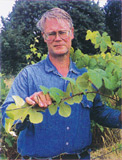| Cover |
Contents |
Next Article |
Grapes In Florida Part II
By Lon J. Rombough
Author and grape grower Lon
Rombough, whose new book, The Grape Grower was reviewed last month,
continues his column aimed at the difficult growing conditions of Florida,
USA. Much of the information can be applied to any planting in similar
climates. In fact, he promises more columns for growers in hot humid conditions. Last time we saw that the biggest obstacle to growing grapes in
Florida, and many other tropical type climates, is that the diseases
of grapes LOVE warm, humid tropical type climates. Fortunately, there
have been enough attempts at growing grapes in such climates that we
have a lot of answers to the problem of disease.
Last time we saw that the biggest obstacle to growing grapes in
Florida, and many other tropical type climates, is that the diseases
of grapes LOVE warm, humid tropical type climates. Fortunately, there
have been enough attempts at growing grapes in such climates that we
have a lot of answers to the problem of disease.The first answer is avoidance. Not all tropical areas are infested with diseases that can attack grapes. Many tropical areas of the world have remained free of many of the fungal diseases because those pests have not reached everywhere. While spores of most of them are airborne, they haven't successfully traveled to many other countries. Most of the time such diseases had to be carried on infected plants, and there are so many tropical areas where no one has taken grapes in any form, so they are free of the pests unless someone carries them along.
In the eastern U.S., however, you won't avoid the fungal diseases - they are everywhere, though even in the South there are locales such as the high altitudes of the Carolinas where cooler, drier conditions mean that grape diseases are at least less virulent and easier to control.
In other tropical areas, it can be worth checking around to see if grapes have ever been grown there. If not, try a small planting of various varieties. You might get lucky and be where serious disease of grapes don't exist. Be sure to get clean stock so you don't bring the diseases in yourself, though. More on this another time.
The second way to deal with tropical climates is to grow varieties that are resistant to the diseases. In this, Nature has given us a BIG hand. Native species of grapes have grown in Florida and the humid southeast for an extremely long time. They've learned to co-exist with the grape diseases and, as a result, many have very high levels of disease resistance. Grape growers and breeders have made good use of many of these wild species so that there are several types and classes of resistant grapes that will survive and grow in tropical conditions with surprisingly little care. Some include:
Muscadine grapes (Muscadinia rotundifolia and related species). Muscadines, as a species, are some of the healthiest of the grapes, able to grow without spray in the midst of diseases and pests that would kill most other grapes. They are so distinct from other grapes in so many ways, that they are placed in their own genus, Muscadinia while all other grapes are of the genus Vitis. The most obvious distinction between Muscadines and other grapes is that the berries of Muscadines drop from the small clusters when ripe, while the fruit of their grapes hangs onto their clusters. As a result, Vitis grapes are commonly known as bunch grapes, because the berries are in bunches, while Muscadine grapes have only small clusters.
Other distinguishing factors of muscadines include extremely tough skin and a pronounced aroma. People who eat muscadines talk of sucking the juice and spitting out the thick, tough skin as 'hulls.' And while people used to standard grocery store grapes might have to work to get used to eating muscadines, they wouldn't have any trouble getting used to the juice. Though the skin of muscadines is tough, it's not harsh or astringent, having a mild, apple-like flavor much of the time. As a result, the flavors it adds to the juice make a really nice, light, fruity grape juice.
All muscadines are not created equally, though. Besides the usually differences in berry size and color, the vines themselves vary both in disease resistance and adaptability. Muscadines bred in Georgia with it's heavy clay soils, for example, often don't perform as well in the light sandy soils of Florida. Conversely, Florida types may lack cold hardiness in other states, as well as lacking ability to grow well in heavy soils.
Generally, though, muscadines are a good choice for a trouble free grape for the southeast.
More on muscadines in particular another time, and we will continue with other grapes for tropical climates in the next column.
